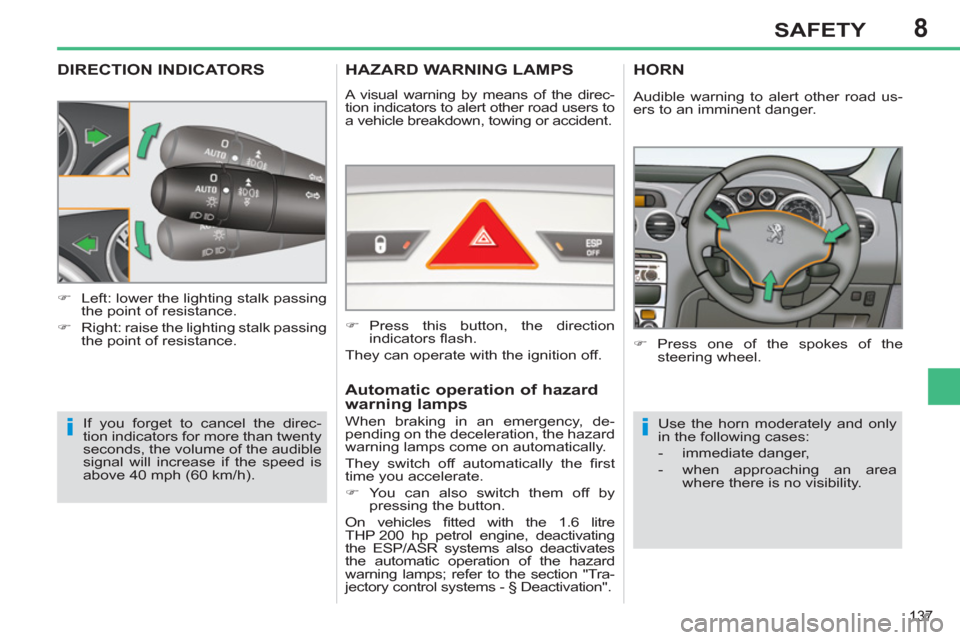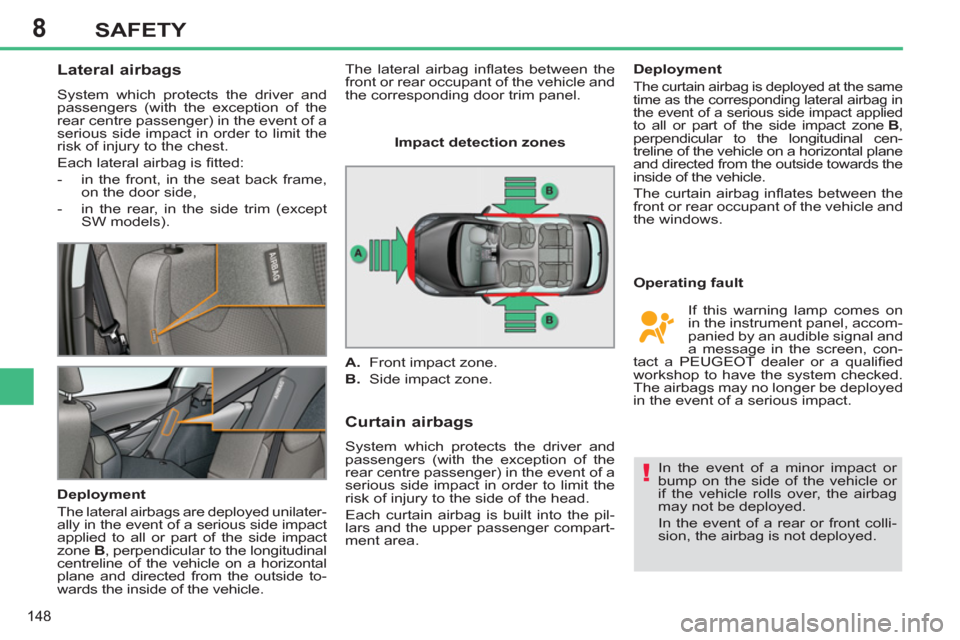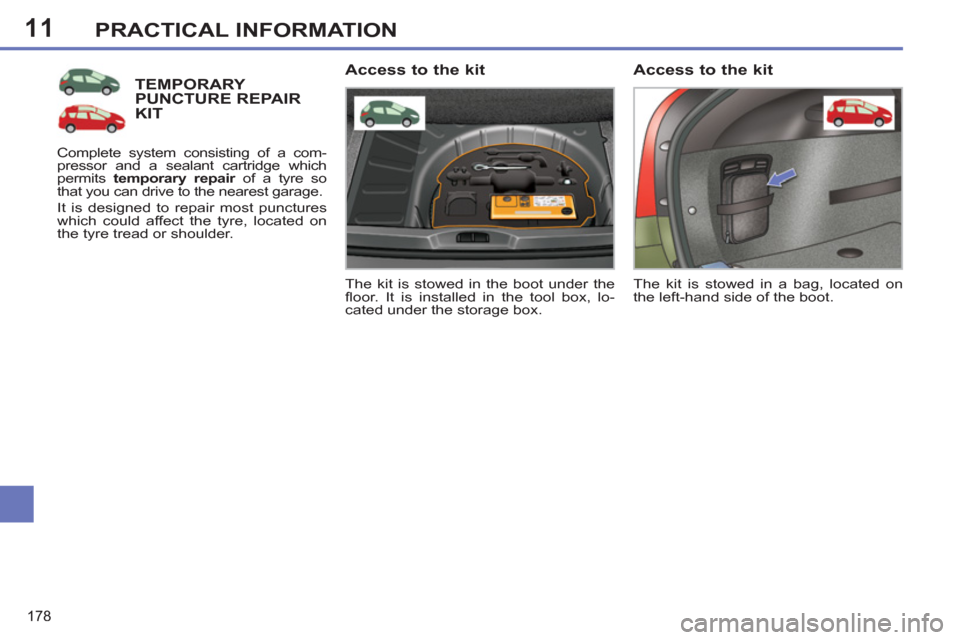2012.5 Peugeot 308 SW BL tow
[x] Cancel search: towPage 139 of 382

8
137
SAFETY
DIRECTION INDICATORS
If you forget to cancel the direc-
tion indicators for more than twenty
seconds, the volume of the audible
signal will increase if the speed is
above 40 mph (60 km/h).
�)
Left: lower the lighting stalk passing
the point of resistance.
�)
Right: raise the lighting stalk passing
the point of resistance.
HAZARD WARNING LAMPS
A visual warning by means of the direc-
tion indicators to alert other road users to
a vehicle breakdown, towing or accident.
�)
Press this button, the direction
indicators fl ash.
They can operate with the ignition off.
Automatic operation of hazard
warning lamps
HORN
�)
Press one of the spokes of the
steering wheel.
Use the horn moderately and only
in the following cases:
- immediate danger,
- when approaching an area
where there is no visibility.
Audible warning to alert other road us-
ers to an imminent danger.
When braking in an emergency, de-
pending on the deceleration, the hazard
warning lamps come on automatically.
They switch off automatically the fi rst
time you accelerate.
�)
You can also switch them off by
pressing the button.
On vehicles fi tted with the 1.6 litre
THP 200 hp petrol engine, deactivating
the ESP/ASR systems also deactivates
the automatic operation of the hazard
warning lamps; refer to the section "Tra-
jectory control systems - § Deactivation".
Page 147 of 382

8
145
SAFETY
The driver must ensure that passen-
gers use the seat belts correctly and
that they are all restrained securely
before setting off.
Wherever you are seated in the ve-
hicle, always fasten your seat belt,
even for short journeys.
Do not interchange the seat belt
buckles as they will not fulfi l their role
fully.
The seat belts are fi tted with an inertia
reel permitting automatic adjustment
of the length of the strap to your size.
The seat belt is stowed automatically
when not in use.
Before and after use, ensure that the
seat belt is reeled in correctly.
The lower part of the strap must be
positioned as low as possible on the
pelvis.
The upper part must be positioned in
the hollow of the shoulder.
The inertia reels are fi tted with an au-
tomatic locking device which comes
into operation in the event of a col-
lision, emergency braking or if the
vehicle rolls over. You can release
the device by pulling fi rmly on the
strap and releasing it so that it reels
in slightly. In order to be effective, a seat belt
must:
- be tightened as close to the body
as possible,
- be pulled in front of you with a
smooth movement, checking that
it does not twist,
- be used to restrain only one
person,
- not bear any trace of cuts or
fraying,
- not be converted or modifi ed to
avoid affecting its performance.
In accordance with current safety
regulations, for all repairs on your
vehicle, go to a qualifi ed workshop
with the skills and equipment need-
ed, which a PEUGEOT dealer is able
to provide.
Have your seat belts checked regu-
larly by a PEUGEOT dealer or a
qualifi ed workshop, particularly if the
straps show signs of damage.
Clean the seat belt straps with soapy
water or a textile cleaning product,
sold by PEUGEOT dealers.
After folding or moving a seat or rear
bench seat, ensure that the seat belt
is positioned and reeled in correctly.
Recommendations for children
Use a suitable child seat if the pas-
senger is less than 12 years old or
shorter than one and a half metres.
Never use the same seat belt to se-
cure more than one person.
Never allow a child to travel on your
lap.
In the event of an impact
Depending on the nature and se-
riousness of the impact
, the pre-
tensioning device may be deployed
before and independently of the
airbags. Deployment of the preten-
sioners is accompanied by a slight
discharge of harmless smoke and
a noise, due to the activation of the
pyrotechnic cartridge incorporated in
the system.
In all cases, the airbag warning lamp
comes on.
Following an impact, have the seat
belts system checked, and if neces-
sary replaced, by a PEUGEOT dealer
or a qualifi ed workshop.
Page 150 of 382

8
148
SAFETY
Lateral airbags
System which protects the driver and
passengers (with the exception of the
rear centre passenger) in the event of a
serious side impact in order to limit the
risk of injury to the chest.
Each lateral airbag is fi tted:
- in the front, in the seat back frame,
on the door side,
- in the rear, in the side trim (except
SW models).
Deployment
The lateral airbags are deployed unilater-
ally in the event of a serious side impact
applied to all or part of the side impact
zone B
, perpendicular to the longitudinal
centreline of the vehicle on a horizontal
plane and directed from the outside to-
wards the inside of the vehicle.
Curtain airbags
System which protects the driver and
passengers (with the exception of the
rear centre passenger) in the event of a
serious side impact in order to limit the
risk of injury to the side of the head.
Each curtain airbag is built into the pil-
lars and the upper passenger compart-
ment area.
Operating fault
Deployment
The curtain airbag is deployed at the same
time as the corresponding lateral airbag in
the event of a serious side impact applied
to all or part of the side impact zone B
,
perpendicular to the longitudinal cen-
treline of the vehicle on a horizontal plane
and directed from the outside towards the
inside of the vehicle.
The curtain airbag infl ates between the
front or rear occupant of the vehicle and
the windows.
In the event of a minor impact or
bump on the side of the vehicle or
if the vehicle rolls over, the airbag
may not be deployed.
In the event of a rear or front colli-
sion, the airbag is not deployed.
Impact detection zones
A.
Front impact zone.
B.
Side impact zone.
If this warning lamp comes on
in the instrument panel, accom-
panied by an audible signal and
a message in the screen, con-
tact a PEUGEOT dealer or a qualifi ed
workshop to have the system checked.
The airbags may no longer be deployed
in the event of a serious impact. The lateral airbag infl ates between the
front or rear occupant of the vehicle and
the corresponding door trim panel.
Page 161 of 382

9
PRND
159
DRIVING
To limit fuel consumption when sta-
tionary for long periods with the en-
gine running (traffi c jam...), place the
gear lever in position N
and apply
the parking brake.
Return to standard automatic
operation
�)
At any time, press the button
selected again to quit the programme
engaged and return to auto-adaptive
mode.
Manual operation
�)
Select position M
for sequential
changing of the four or six gears.
�)
Push the lever towards the +
sign to
change up a gear.
�)
Pull the lever towards the -
sign to
change down a gear.
It is only possible to change from one
gear to another if the vehicle speed and
engine speed permit; otherwise, the
gearbox will operate temporarily in au-
tomatic mode.
D
disappears and the gears
engaged appear in succes-
sion on the instrument panel.
If the engine speed is too low or too
high, the gear selected fl ashes for a few
seconds, then the actual gear engaged
is displayed.
It is possible to change from position D
(automatic) to position M
(manual) at
any time.
When the vehicle is stationary or mov-
ing very slowly, the gearbox selects
gear M1
automatically. The sport and snow programmes do not
operate in manual mode.
Invalid value during manual
operation
This symbol is displayed if a
gear is not engaged correctly
(selector between two posi-
tions).
Stopping the vehicle
Before switching off the engine, you
can engage position P
or N
to place the
gearbox in neutral.
In both cases, apply the parking brake
to immobilise the vehicle.
If the lever is not in position P
,
when the driver's door is opened or
approximately 45 seconds after the
ignition is switched off, an audible
signal is heard and a message ap-
pears in the screen.
�)
Return the lever to position P
;
the audible signal stops and the
message disappears.
Operating fault
There is a risk of damage to the
gearbox:
- if you press the accelerator and
brake pedals at the same time,
- if you force the lever from
position P
to another position
when the battery is fl at.
When the ignition is on, the
lighting of this warning lamp, ac-
companied by an audible signal
and a message in the screen,
indicates a gearbox fault.
In this case, the gearbox switches
to emergency mode and is locked in
3rd gear. You may feel a substantial
knock when changing from P
to R
and
from N
to R
. This will not cause any
damage to the gearbox.
Do not exceed a speed of 60 mph
(100 km/h), local speed restrictions per-
mitting.
Have it checked by a PEUGEOT dealer
or a qualifi ed workshop.
This warning lamp may also come on if
a door is opened.
Page 170 of 382

9
168
DRIVING
Front parking sensors
In addition to the rear parking sensors, the
front parking sensors are triggered when
an obstacle is detected in front and the
speed of the vehicle is still below 6 mph
(10 km/h).
The front parking sensors are interrupted
if the vehicle stops for more than three
seconds in forward gear, if no further ob-
stacles are detected or when the speed of
the vehicle exceeds 6 mph (10 km/h).
Deactivation / Activation of the front
and rear parking sensors
Deactivation / Activation of the rear
parking sensors
The function will be deactivated au-
tomatically if a trailer is being towed
or a bicycle carrier is fi tted (vehicle
fi tted with a towbar or bicycle car-
rier recommended by PEUGEOT).
Operating fault
In bad weather or in winter, ensure
that the sensors are not covered
with mud, ice or snow. When re-
verse gear is engaged, an audible
signal (long beep) indicates that
the sensors may be dirty.
When the vehicle is moving at a
speed below 6 mph (10 km/h), cer-
tain sound sources (motorcycle,
lorry, pneumatic drill, etc.) may trig-
ger the audible signals of the parking
sensor system.
The function is deactivated by pressing
this button. The indicator lamp in the
button comes on.
Pressing this button again reactivates
the function. The indicator lamp in the
button goes off.
The function is deactivated
or activated via the vehicle
confi guration menu.
The status of the function
is stored when the ignition
is switched off.
For more information on ac-
cess to the parking sensors menu, refer
to the section covering the confi guration
of vehicle systems.
In the event of a malfunction of
the system, when reverse gear
is engaged this warning lamp
is displayed in the instrument
panel and/or a message appears in the
screen, accompanied by an audible sig-
nal (short beep).
Contact a PEUGEOT dealer or a qualifi ed
workshop.
The sound emitted by the speaker (front
or rear) indicates whether the obstacle
is in front or behind.
Page 179 of 382

10
177
CHECKS
Brake disc wear
Brake pads
Brake wear depends on the
style of driving, particularly in
the case of vehicles used in
town, over short distances. It
may be necessary to have the
condition of the brakes checked, even
between vehicle services.
Unless there is a leak in the circuit, a
drop in the brake fl uid level indicates
that the brake pads are worn.
For information on checking
brake disc wear, contact a
PEUGEOT dealer or a quali-
fi ed workshop.
Manual gearbox
The gearbox does not re-
quire any maintenance (no oil
change).
Refer to the servicing book-
let for the details of the level
checking interval for this com-
ponent.
6-speed electronic gearbox
The gearbox does not re-
quire any maintenance (no oil
change).
Refer to the servicing booklet
for details of the checking in-
terval for this component.
Automatic gearbox
The gearbox does not re-
quire any maintenance (no oil
change).
Refer to the servicing booklet
for details of the level checking
interval for this component.
Only use products recommended
by PEUGEOT or products of equi-
valent quality and specifi cation.
In order to optimise the operation
of units as important as the braking
system, PEUGEOT selects and
offers very specifi c products.
To avoid damaging the electrical
units, the use of a high pressure
washer in the engine compartment
is strictly prohibited
.
Parking brake
If excessive travel or a loss of
effectiveness of this system
is noticed, the parking brake
must be checked, even be-
tween two services.
Checking this system must be done by
a PEUGEOT dealer or a qualifi ed work-
shop.
Page 180 of 382

11
178
PRACTICAL INFORMATION
TEMPORARY PUNCTURE REPAIRKIT
The kit is stowed in the boot under the
fl oor. It is installed in the tool box, lo-
cated under the storage box.
Access to the kit
Complete system consisting of a com-
pressor and a sealant cartridge which
permits temporary repair
of a tyre so
that you can drive to the nearest garage.
It is designed to repair most punctures
which could affect the tyre, located on
the tyre tread or shoulder.
Access to the kit
The kit is stowed in a bag, located on
the left-hand side of the boot.
Page 184 of 382

11
182
PRACTICAL INFORMATION
�)
Turn the selector A
to the
"air" position.
�)
Uncoil the black pipe H
fully.
�)
Connect the black pipe to
the valve of the wheel.
�)
Connect the compressor's electric
plug to the vehicle's 12 V socket.
�)
Start the vehicle again and leave the
engine running.
�)
Visit a PEUGEOT dealer or a
qualifi ed workshop as soon as
possible.
You must inform the technician
that you have used this kit.
After inspection, the technician
will inform you whether the tyre
can be repaired or must be
replaced.
2. Infl ation
�)
Adjust the pressure using the
compressor (to infl ate: switch B
in
position "I"
; to defl ate: switch B
in
position "O"
and press button C
), in
accordance with the vehicle's tyre
pressure label (located on the left
hand door aperture).
A loss of pressure indicates that the
puncture has not been fully plugged;
contact a PEUGEOT dealer or
qualifi ed workshop for assistance.
�)
Remove and stow the kit.
�)
Drive at reduced speed (50 mph
[80 km/h] max) limiting the distance
travelled to approximately 120 miles
(200 km).